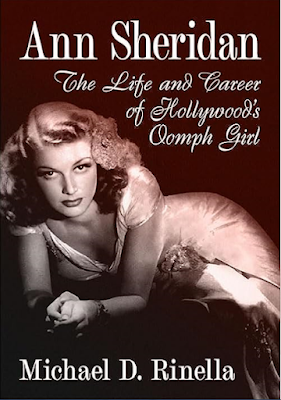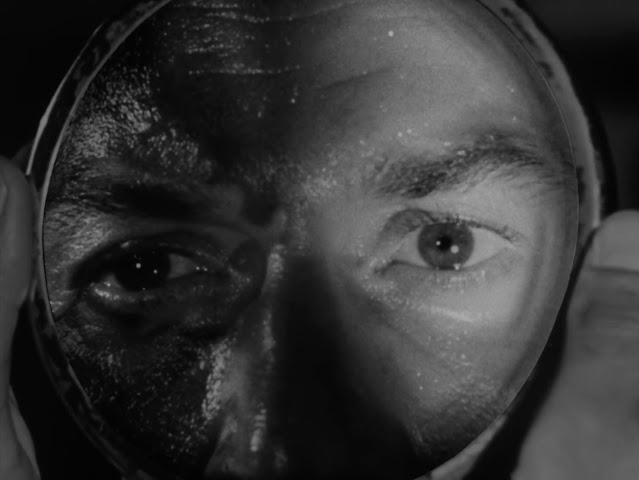 |
| Annie gets her due--at last!--with the first Ann Sheridan biography. |
It's noteworthy that Ann Sheridan,
from Hollywood’s golden era, is getting her first biography some 57 years after
her death in 1967. How fortunate that Sheridan has admirer Michael D. Rinella
as her biographer. His book is a meticulous, empathetic, and honest account of
the film actress. Ann Sheridan: The Life
and Career of Hollywood’s Oomph Girl by Michael D. Rinella is out now.
 |
| Ann Sheridan in her Warner Brothers heyday. |
Other ‘40s film sex
symbols have gotten their star bios: Grable, Turner, Hayworth, etc. The big
difference is that Ann Sheridan was a popular star in her time, but Ann’s
career soon evaporated after she left Warner Brothers. While her personal life
was lively, it was not as legendary as those of Crawford, Turner, or Hayworth.
The most significant reason she faded in the public's mind was that she died at
51 in 1967. Biographer Rinella remedies all this with a book that
thoroughly and engagingly shows where Clara Lou Sheridan came from (Texas) and
her rise to Hollywood stardom at Warner Brothers.
 |
| One of Ann Sheridan's first good roles was in 1938's "Angels with Dirty Faces," with James Cagney and Pat O'Brien. |
Thanks to the enduring
magic of classic films and later TCM, Ann Sheridan began getting her due as a
versatile, charismatic performer: Ann had a flair for comedy, was natural as a
dramatic actress, and could also sing. She was also a natural redhead who
looked like a cross between contemporaries Rita Hayworth and Lucille Ball. Sheridan’s
natural pizzazz inspired WB’s publicity to dub her "The Oomph Girl."
 |
| Ann Sheridan mixed glamour with tongue in cheek humor. |
What's beneficial to
the reader is that author Rinella uses many quotes from interviews by Sheridan
herself. Lucky for Rinella that Sheridan was plain-spoken, especially for the
era. Sheridan reminded me of the late great Carole Lombard, also very candid.
Ann was self-aware, with a self-deprecating sense of humor.
 |
| Ann Sheridan finally got a lead where she could shine, in 1940's "It All Came True." |
Some stars are born
with their first Hollywood film, like Greer Garson, Katharine Hepburn, or
Lauren Bacall. For others, the ascent is arduous, as with Marilyn Monroe, Betty
Grable, or Ann Sheridan. It doesn't always have to do with talent, but with studio
promotion or just plain luck. It helps to have a studio head, producer, or
director in an actor’s corner. With certain starlets, even if the public showed
interest, sometimes the moguls or execs still looked down on them. L.B. Mayer
much preferred his great ladies like Garbo, Shearer, etc. over brassy Jean
Harlow, who Sheridan was compared to later. Monroe, Grable, and Sheridan were
starlets for a long spell, before going on to another studio and achieving
stardom.
Once Betty Grable hit
at 20th Century Fox, she got the star treatment. Monroe and Sheridan
were underpaid despite their popularity—Monroe with her second try at Fox,
Sheridan from Paramount to WB. Both legally fought their respective moguls,
Darryl Zanuck and Jack Warner. The difference was Sheridan had self-confidence,
was pragmatic, and well-liked by studio folk; Monroe was often treated like the
red-headed step-child at Fox, and it got under her skin.
 |
| This time, Ann Sheridan was front and center with Cagney & O'Brien in 1940's "Torrid Zone." |
Rinella does a fine
job offering background info on significant people in Sheridan's life. It helps
clarify Annie’s life and career decisions. As for her Ann herself, while Rinella
is a Sheridan fan, he is clear-eyed in depicting shortcomings regarding personal
and professional traits that hindered her career.
 |
| Forget "The Man Who Came to Dinner" himself, it was Ann Sheridan as vain star Lorraine Sheldon who stole the show! |
Like most stars, while
Ann wanted to demonstrate her talents, she also fell into the traps common
among the era's stars. She turned down the role as The Strawberry Blonde, because while it was the title character, it
was a secondary role. Yet, it was one that helped Rita Hayworth become a star.
She was one of many who turned down Mildred
Pierce, rightfully here, as she was
only 30. Ann turned down To Have and Have
Not, though she loved Bogie, perhaps because it was a lot like the role in Torrid Zone. Warner wanted her for a
role in Caged, but Sheridan might
have suggested herself for the warden role, played by Agnes Moorehead. But
Annie didn't see herself in character roles. Thus, her Kings Row co-star Betty Field, who looked like a sourpuss version
of Sheridan, ended up in juicy later roles in huge hits Picnic, Bus Stop, Peyton Place, and BUtterfield 8. Ann’s professional pride in maintaining her leading
lady status was intact, but what good is being a star if you have no place to
shine?
In Sheridan’s personal
life—the night life, drinking, and chain-smoking—all took its toll on the star's
good looks. This was not an unusual problem for both male and female stars of
the golden era. The biggest stars that still drew audiences were given extra
attention with their makeup, hair, and lighting. Lana Turner, Joan Crawford, and
Lucille Ball come to mind. So do Rita, Ava, and later, Elizabeth Taylor. The
stars who were no longer a draw, like Sheridan and Joan Blondell—not so
much.
Admirably, Sheridan
did try to advance her own post-studio career, pushing independent film
properties, trying television, and later the stage. This is where luck comes
in, too. For aging stars, especially women, the 50's and 60's were pretty slim
pickings as there were so many stars in the same boat.
Rinella gives great
details of Ann's uphill battle to film stardom and how often she was unlucky or
foolhardy in love. I always thought George Brent was an odd choice as a
Sheridan spouse. Ann was so lively and George was such a dullard on film. Turns
out Brent was moody and anti-social, also very un-Ann Sheridan! I asked the
author why Sheridan never had children. While Rinella is an extremely thorough
researcher, he could not come up with any definitive info on that subject, but
I bet that it affected her personal outlook, too.
Rinella writes a most touching
look at Sheridan's last years, as she worked more in television and onstage,
with varying results. Ann also had some cosmetic procedures that bolstered her
last appearances, like the CBS western spoof, Pistols ‘n’ Petticoats. But sadly, it was then that Sheridan found
out she had throat cancer. She declined rapidly and died January 21, 1967,
exactly a month before her 52nd birthday. Fortunately, Sheridan had found
happiness with actor Scott McKay, her last husband.
 |
| Ann Sheridan's last role was in CBS's western spoof, "Pistols 'n' Petticoats." Cancer was already taking its toll. |
While Ann's talents
have become reassessed, it's still slow compared to some other actors who have
been rediscovered. Ann Sheridan's gift for mixing comedy and drama reminds me a
lot of Carole Lombard. Sheridan also had that brash side like Harlow when she
became an able comic actor. And Annie's acerbic way with a one-liner was equal
to the great Eve Arden.
 |
| Ann Sheridan starred with Bogie& George Raft in 1940's "They Drive By Night." Ida Lupino went big as the bad girl, but Ann held her own as a good-hearted waitress. |
For those who want to
watch more Ann Sheridan, she's good in urban melodramas Angels with Dirty Faces, City
of Conquest, and They Drive by Night.
Sheridan outshines the entire young cast with her warm performance as Randy Monaghan
in Kings Row. Later, Sheridan did
well in romantic noirs like Nora Prentiss,
The Unfaithful, and Woman on the Run. And Annie was aces in
comedies: It All Came True, Torrid Zone, The Man Who Came to Dinner, The
Doughgirls, George Washington Slept
Here, and I Was a Male War Bride.
Not a bad legacy for Ann Sheridan, an actress not often given the star
treatment.
 |
| Ann Sheridan & Cary Grant were a hoot together in Howard Hawk's 1948 screwball comedy, "I Was a Male War Bride." Annie should have worked with Hawks more! |
Cher once described
her own acting range as being great at playing "tarts with a heart."
The same was true of Ann Sheridan, memorable as working class girls with a
heart of gold. Sheridan had oomph, a phrase she hated, but also
authenticity as an honest actress within her range.
.jpg) |
| Ann Sheridan played many of these kind of girls in her movie glory days! |
Michael D. Rinella
puts Ann Sheridan back in the limelight, with a most knowledgeable, readable,
and thoughtful biography that depicts her life and career with honesty.
 |
| See the link below to find out more or to order this new Ann Sheridan biography. |
Here’s Amazon’s link
to Ann
Sheridan: The Life and Career of Hollywood’s Oomph Girl: https://www.amazon.com/Ann-Sheridan-Career-Hollywoods-Oomph/dp/1476694184
 |
| Ann Sheridan as "Nora Prentiss," the nicest film noir femme fatale ever! |
My look at Ann
Sheridan in her film noir phase, as Nora
Prentiss: https://ricksrealreel.blogspot.com/2019/02/ann-sheridans-glamour-brightens-gloomy.html
 |
| Ann Sheridan in her best role, as Randy in 1942's "Kings Row." |
My take on Ann in her best film role, as Randy in 1942’s Kings Row: https://ricksrealreel.blogspot.com/2017/01/kings-row-is-much-more-than-reagans.html

























